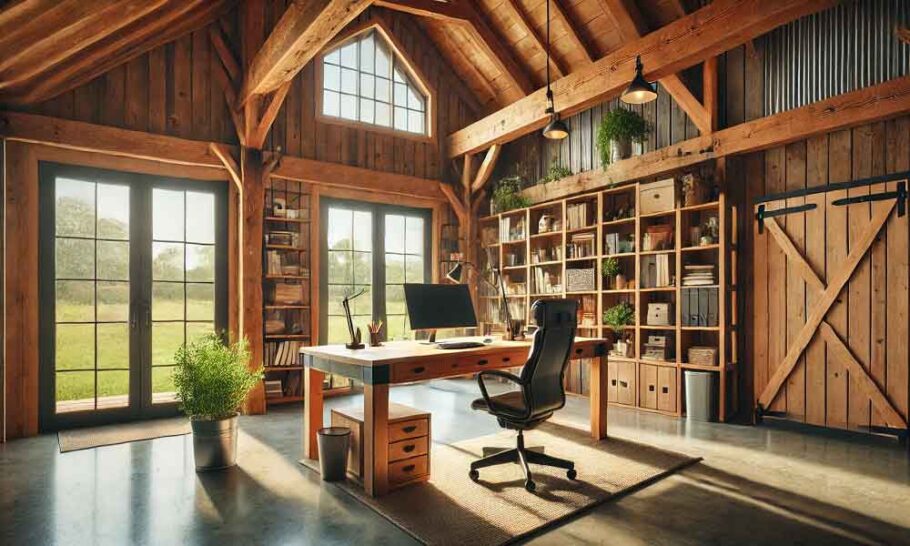As remote work becomes more common, creating a dedicated home office space in your barndominium is an essential part of the design process. A well-thought-out workspace can boost productivity, enhance comfort, and even increase the overall value of your home. Whether you’re a full-time remote worker or just need a space for occasional projects, this guide will help you design a functional and inspiring home office in your barndominium.
Key Considerations for Barndominium Home Office Design
- Location and Layout
Choosing the right location for your home office is crucial. Look for a space that offers privacy and is away from high-traffic areas such as the kitchen or living room.
- Dedicated Room vs. Open Space: If possible, allocate a separate room for your office to minimize distractions. In open-plan barndominiums, consider partial walls or dividers to create a defined workspace.
- Proximity to Natural Light: Position your office near windows to take advantage of natural light, which can improve mood and reduce eye strain.
- Lighting
Proper lighting is essential for a productive workspace.
- Natural Light: Incorporate large windows, skylights, or glass doors to maximize natural light. Use blinds or curtains to control glare.
- Task Lighting: Install adjustable desk lamps or overhead task lights to illuminate your work area without causing shadows.
- Ambient Lighting: Add soft, warm lighting fixtures to create a comfortable and inviting atmosphere, especially for evening work sessions.
- Privacy
Privacy is critical for maintaining focus, especially in a shared household.
- Soundproofing: Use soundproof materials such as acoustic panels, heavy curtains, or rugs to reduce noise from other parts of the barndominium.
- Door Options: Install a solid-core door for better sound insulation. Sliding barn doors are a stylish option but may need additional measures to block sound.
- Zoning: Position your office away from communal areas like the kitchen or living room to minimize disruptions.
Design Elements for Comfort and Productivity
- Ergonomics
Invest in ergonomic furniture to ensure long-term comfort and reduce the risk of strain.
- Adjustable Desk: Consider a sit-stand desk to alternate between sitting and standing throughout the day.
- Ergonomic Chair: Choose a chair with adjustable height, lumbar support, and armrests.
- Monitor Setup: Position your monitor at eye level and about an arm’s length away to reduce neck and eye strain.
- Acoustics
Barndominiums often feature open layouts and metal structures, which can amplify sound. To create a quiet workspace:
- Acoustic Panels: Install sound-absorbing panels on walls or ceilings to reduce echo and noise.
- Soft Materials: Use area rugs, upholstered furniture, and curtains to dampen sound.
- White Noise Machine: Consider a white noise machine or background music to mask distracting sounds.
- Storage and Organization
Clutter can hinder productivity, so plan for ample storage solutions:
- Shelving: Install floating shelves or built-in cabinets to store books, supplies, and decor.
- Storage Cabinets: Use cabinets with doors to conceal clutter and maintain a clean look.
- Cable Management: Use cable organizers or conduits to keep cords out of sight.
Aesthetic Considerations
A visually pleasing office can inspire creativity and make work more enjoyable.
- Color Palette: Choose calming colors like blues, greens, or neutrals to create a serene environment.
- Personal Touches: Add artwork, plants, or photos to personalize your space.
- Textures and Materials: Incorporate natural materials like wood or stone to complement the rustic-modern aesthetic of a barndominium.
Technology and Connectivity
A functional home office needs reliable technology and connectivity.
- High-Speed Internet: Ensure your barndominium is equipped with high-speed internet, especially if you’re in a rural area. Satellite or fiber-optic options may be necessary.
- Power Outlets: Install sufficient power outlets, including USB ports, to accommodate all your devices.
- Backup Power: Consider a backup generator or uninterruptible power supply (UPS) to avoid disruptions during power outages.
Flexibility for Multi-Purpose Use
Your home office doesn’t have to be a single-purpose space. Design it to accommodate other uses when not in work mode.
- Convertible Furniture: Use a fold-away desk or a Murphy bed to convert the office into a guest room.
- Meeting Space: Add a small table and chairs for in-person meetings or collaborative projects.
Cost Considerations
The cost of setting up a home office can vary depending on your choices.
- Budget-Friendly Options: Opt for DIY solutions like repurposing furniture or using peel-and-stick wallpaper for a quick refresh.
- High-End Investments: Consider investing in high-quality ergonomic furniture and advanced soundproofing for long-term benefits.
Conclusion
Designing a productive and comfortable home office in your barndominium requires careful planning. By focusing on location, lighting, privacy, and ergonomics, you can create a workspace that enhances both your efficiency and well-being. Whether you’re designing a cozy corner or a spacious dedicated room, these tips will help you achieve a functional and stylish office that meets your needs.

